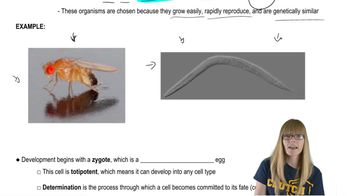Table of contents
- 1. Introduction to Genetics51m
- 2. Mendel's Laws of Inheritance3h 37m
- 3. Extensions to Mendelian Inheritance2h 41m
- 4. Genetic Mapping and Linkage2h 28m
- 5. Genetics of Bacteria and Viruses1h 21m
- 6. Chromosomal Variation1h 48m
- 7. DNA and Chromosome Structure56m
- 8. DNA Replication1h 10m
- 9. Mitosis and Meiosis1h 34m
- 10. Transcription1h 0m
- 11. Translation58m
- 12. Gene Regulation in Prokaryotes1h 19m
- 13. Gene Regulation in Eukaryotes44m
- 14. Genetic Control of Development44m
- 15. Genomes and Genomics1h 50m
- 16. Transposable Elements47m
- 17. Mutation, Repair, and Recombination1h 6m
- 18. Molecular Genetic Tools19m
- 19. Cancer Genetics29m
- 20. Quantitative Genetics1h 26m
- 21. Population Genetics50m
- 22. Evolutionary Genetics29m
15. Genomes and Genomics
Functional Genomics
Problem 21b
Textbook Question
The eyes of Drosophila develop from imaginal discs, groups of cells set aside in the fly embryo that differentiate into the adult structures during the pupal stage. Despite their importance in nature, eyes are dispensable for fruit-fly life in the laboratory.
Devise a genetic screen to identify genes directing development of the fly eye.
 Verified step by step guidance
Verified step by step guidance1
<span>Step 1: Understand the goal of the genetic screen, which is to identify genes involved in the development of the Drosophila eye. This involves creating a method to observe and select for mutations that affect eye development.</span>
<span>Step 2: Choose a mutagenesis method to induce mutations in the Drosophila genome. Common methods include chemical mutagens like EMS (ethyl methanesulfonate) or radiation. These methods will create random mutations throughout the genome.</span>
<span>Step 3: Design a screening strategy to identify flies with eye development defects. This could involve examining the eyes of adult flies under a microscope to look for visible abnormalities such as size, shape, or color changes.</span>
<span>Step 4: Cross the mutagenized flies with a wild-type strain to establish lines that carry the mutations. This helps in maintaining the mutations and allows for further analysis of the genetic basis of the observed phenotypes.</span>
<span>Step 5: Map the mutations to specific genes using genetic mapping techniques. This could involve complementation tests with known mutations, or modern techniques like whole-genome sequencing to identify the exact genetic changes responsible for the eye development defects.</span>
Recommended similar problem, with video answer:
 Verified Solution
Verified SolutionThis video solution was recommended by our tutors as helpful for the problem above
Video duration:
2mPlay a video:
Was this helpful?
Key Concepts
Here are the essential concepts you must grasp in order to answer the question correctly.
Imaginal Discs
Imaginal discs are clusters of undifferentiated cells in the larval stage of Drosophila that later develop into adult structures, including the eyes. These discs are crucial for understanding how specific genes influence the formation of complex organs during metamorphosis, as they serve as the precursors to adult tissues.
Recommended video:
Guided course

Supercoiling
Genetic Screening
Genetic screening is a method used to identify and isolate specific genes associated with particular traits or developmental processes. In the context of Drosophila, this involves mutating or manipulating genes and observing the resulting phenotypes, which helps pinpoint the genetic factors that control eye development.
Recommended video:
Guided course

Descriptive Genetics
Pupal Stage Development
The pupal stage is a critical phase in the life cycle of Drosophila where significant morphological changes occur, transforming the larva into an adult fly. Understanding this stage is essential for identifying the timing and regulation of gene expression that directs the development of the eye and other structures during this metamorphosis.
Recommended video:
Guided course

Genetics of Development

 8:26m
8:26mWatch next
Master Functional Genomics with a bite sized video explanation from Kylia Goodner
Start learningRelated Videos
Related Practice


